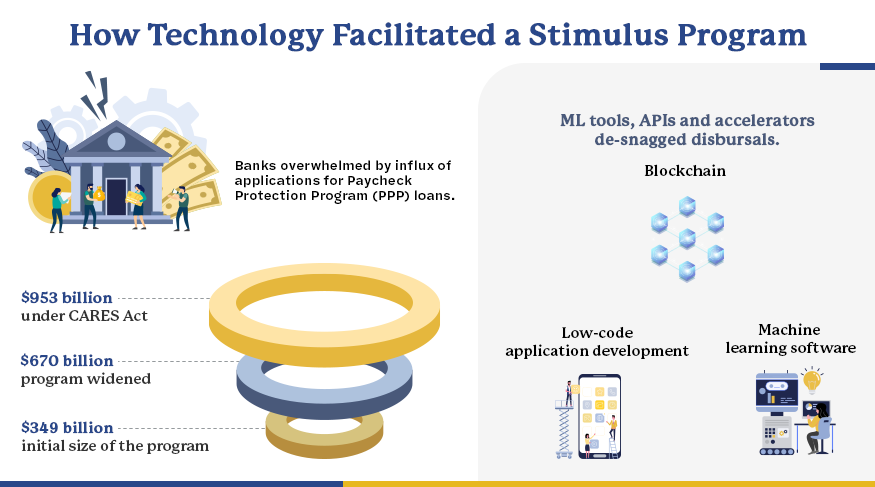Home » Industries » Banking & Financial Services » Banking » Innovation expedites pandemic relief

When the U.S. government in March 2020 announced its Paycheck Protection Program (PPP) to help small businesses with loans to continue paying employee wages and lease rents, it was not fully prepared to deal with the system choking up. Technology came to the rescue, where service providers tapped API-based systems and the like to smoothen the process of routing the relief loans to genuine borrowers.
The $349-billion PPP initiative, which later enlarged to $670 billion, was part of the $2.2 trillion CARES Act that aimed to help businesses tide over the economic downturn in the wake of the pandemic lockdowns.
The plan was for banks to disburse the loans through the Small Business Administration (SBA). Many banks had taken the traditional route of creating the standard workflows they had used for loan disbursal programs. But those systems were not geared for disbursing the massive amounts in loans in a short period, which was critical to keep afloat especially small businesses.
As it happened, the influx of loan applications overwhelmed the banking system’s infrastructure. It was not as easy as hooking up to a web screen, querying for a particular loan, submitting all the customer details, and securing sanction for the loan. Furthermore, banks and the SBA faced obstacles in accurately ascertaining the creditworthiness of loan applicants, identifying and weeding out fraudulent applications, and eventually onboarding borrowers.
Overcoming the hurdle of legacy infrastructure
Technology service providers met the challenges on multiple fronts. For instance, blockchain technology, low-code application development platforms like Appian and Mendix and machine learning software were linked to loan origination systems. They integrated the SBA’s processes with API-based systems, which the agency lacked at the time.
The low-code applications defined the process in visual programming, like a workflow, and then it automatically could detect various cascading or impacted systems. Bank systems could then intervene as needed, such as in fetching and feeding additional information. They could create an integrated view of the entire process, and across the banking system.
While the first month was all about manual processing of loan applications, within weeks, technology providers started coming up with accelerators to do the visual programming in the front end, with API-based adaptors in the middleware.
All that helped banks smoothen the path for onboarding borrowers, mapping out their needs and establishing their creditworthiness. The system also helped ascertain new behaviors that prevented fraudulent applications in the system.
Key takeaways
- Disbursing PPP loans to small businesses in short order overwhelmed the banking system.
- ML-based software, low-code development platforms and API-based systems cleared snags.
- The innovation streamlined borrowers' creditworthiness and onboarding, and prevented fraud.
Contact
Our experts can help you find the right solutions to meet your needs.
Get in touch
